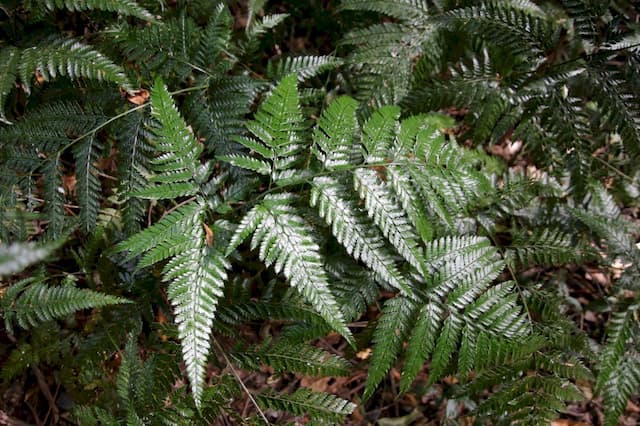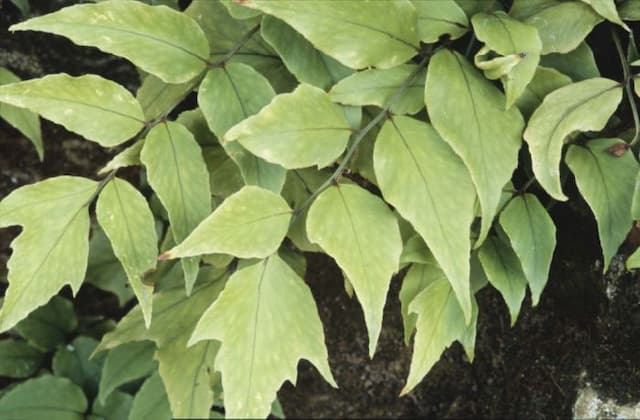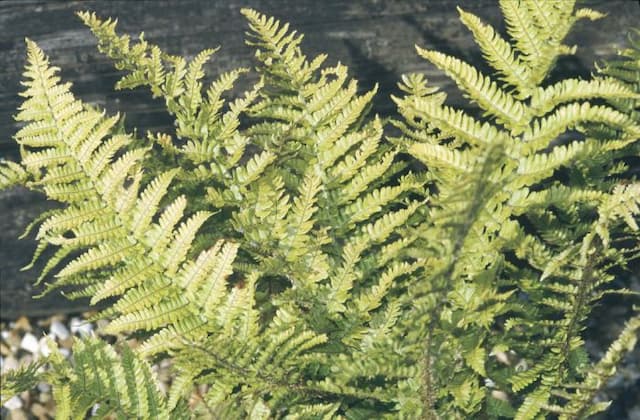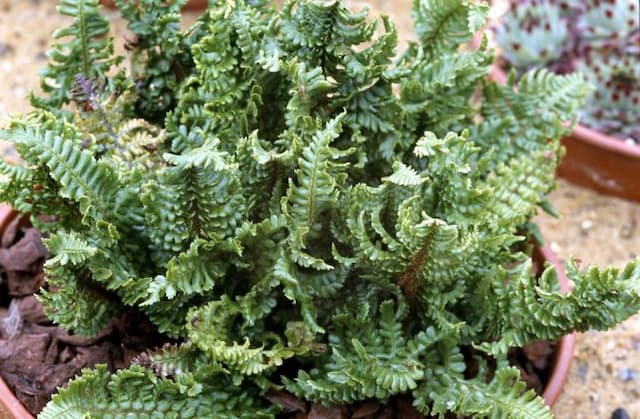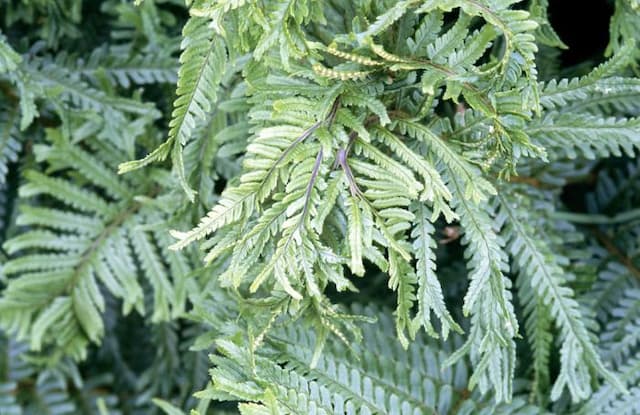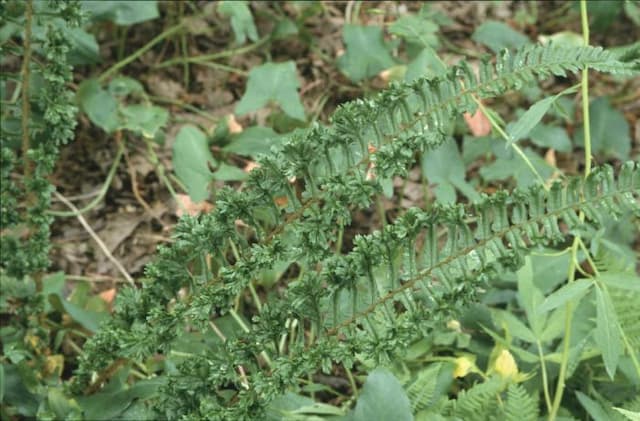Soft shield fern Polystichum setiferum (Divisilobum Group) 'Divisilobum Densum'











ABOUT
The Polystichum setiferum 'Divisilobum Densum', commonly known as the soft shield fern, has an intricate and ornamental appearance that makes it a favorite for garden enthusiasts. The fronds of this graceful fern are finely divided, which gives them a delicate, lace-like texture that seems to dance with the gentlest of breezes. They are arranged in a fountain-like form, creating an elegant, arching shape that adds a touch of sophistication to any garden setting. The soft green color of the fronds is soothing and provides a lush, verdant backdrop to other plants in the garden. Each leaflet is narrow and points softly towards the tip of the frond, creating a soft and inviting look. The overall impression of the soft shield fern 'Divisilobum Densum' is one of lushness and refined beauty, with its intricate fronds adding both visual interest and a feeling of tranquility to the landscape.
About this plant
 Names
NamesFamily
Dryopteridaceae
Synonyms
Soft Shield Fern, Alaskan Fern, Tassel Fern
Common names
Polystichum setiferum (Divisilobum Group) 'Divisilobum Densum'.
 Toxicity
ToxicityTo humans
The Soft Shield Fern (Polystichum setiferum 'Divisilobum Densum') is not known to be toxic to humans. Consequently, ingestion of this plant should not typically cause any poisoning symptoms. However, it is always recommended to avoid ingesting plants that are not specifically grown for consumption, as individual reactions can vary, and other non-toxic effects such as gastrointestinal discomfort could potentially occur.
To pets
The Soft Shield Fern (Polystichum setiferum 'Divisilobum Densum') is generally considered non-toxic to pets. Ingestion of this fern should not result in poisoning symptoms in animals like cats and dogs. As with humans, consuming non-food plants is generally not advised, but accidental ingestion of this particular fern is unlikely to result in more than mild stomach upset, if any symptoms occur at all.
 Characteristics
CharacteristicsLife cycle
Perennials
Foliage type
Evergreen
Color of leaves
Green
Height
3-4 feet (0.9-1.2 meters)
Spread
2-3 feet (0.6-0.9 meters)
Plant type
Fern
Hardiness zones
8
Native area
Europe
Benefits
 General Benefits
General Benefits- Landscape Decoration - The fern adds a lush, green aesthetic to gardens and outdoor spaces with its finely divided, dense, dark green fronds.
- Shade Tolerant - It thrives in shady areas where other plants may struggle, making it ideal for woodland gardens or shaded borders.
- Low Maintenance - Once established, it requires minimal care, making it a good choice for gardeners looking for an easy-to-maintain plant.
- Soil Erosion Control - Its spreading habit and dense foliage can help stabilize soil, preventing erosion in sloped areas.
- Habitat for Wildlife - Provides shelter and breeding grounds for various species of insects and birds, promoting biodiversity.
- Year-Round Interest - Evergreen in nature, it retains its foliage throughout the year, ensuring persistent visual interest in the garden.
- Architectural Plant - Its distinctive textured fronds can be used to create architectural interest in landscape designs.
 Medical Properties
Medical PropertiesThis plant is not used for medical purposes.
 Air-purifying Qualities
Air-purifying QualitiesThis plant is not specifically known for air purifying qualities.
 Other Uses
Other Uses- The soft fronds of Polystichum setiferum, commonly known as Soft Shield Fern, can be used in floristry for creating natural and woodland-style arrangements.
- Soft Shield Fern works well in terrariums or bottle gardens due to its tolerance of humidity and shade, adding a touch of greenery to miniature landscapes.
- The dense foliage provides excellent cover for small garden wildlife, such as frogs and toads, which may use it as hiding and breeding grounds.
- Due to its elegant and intricate foliage, Soft Shield Fern can be used as a subject in botanical illustration and photography, capturing the beauty of nature's patterns.
- In shaded water garden settings, Soft Shield Fern can be planted around ponds or streams to help stabilize the banks and provide a lush backdrop.
- The fern can be used in garden therapy or sensory gardens, where the texture of its leaves adds a tactile element for visitors to touch and feel.
- The fronds can be included in natural dye processes to impart a range of earthy tones to fabrics or crafts materials.
- Its resistance to deer and rabbit browsing makes Soft Shield Fern a great candidate for gardens in rural areas where these animals are common pests.
- In larger landscape designs, the fern can be utilized as a ground cover to suppress weeds with its dense clusters of fronds.
- In artistic compositions such as mandalas or nature art, the symmetrical fronds can be used to create patterns and designs on the forest floor.
Interesting Facts
 Feng Shui
Feng ShuiThe Soft Shield Fern is not used in Feng Shui practice.
 Zodiac Sign Compitability
Zodiac Sign CompitabilityThe Soft Shield Fern is not used in astrology practice.
 Plant Symbolism
Plant Symbolism- Resilience: Polystichum setiferum, commonly known as Soft Shield Fern, is symbolic of resilience due to its ability to thrive in shaded and wooded areas, showing persistence in less than ideal conditions.
- Protection: Ferns often symbolize protection and safety, and the Soft Shield Fern is no exception. It offers a protective cover in the forest and has historically been used in folk medicine for healing, implying a safeguarding nature.
- Eternal Youth: The Soft Shield Fern remains green throughout the year and is often associated with eternal youth and the search for the fountain of youth due to its seemingly everlasting presence in the forest.
- Solitude: As a plant that thrives in quiet, undisturbed areas, the Soft Shield Fern can represent a love of solitude or a peaceful retreat from the world.
- Secretiveness: In the Victorian language of flowers, ferns were often used to symbolize secretiveness or hidden meanings, likely due to their quiet, unassuming growth in shadowy areas.
 Water
WaterThe Soft Shield Fern should be watered deeply once a week, allowing the top inch of soil to dry out between waterings. During the growing season or hotter weather, this may need to be increased to twice a week. Ensure the plant receives about 1 gallon of water at each watering session to thoroughly moisten the soil, depending on the size of the plant and the environmental conditions. Reduce watering in the winter months when the plant's growth slows down. It is important not to overwater as this can lead to root rot.
 Light
LightThe Soft Shield Fern thrives best in partial to full shade. For optimal growth, place it in a spot where it receives dappled sunlight or only morning sun, as strong afternoon sun can scorch its delicate fronds. This fern performs well in the filtered light found under trees or in a shaded garden area.
 Temperature
TemperatureThe Soft Shield Fern prefers temperatures between 60°F and 75°F, which are ideal for its growth and development. It can tolerate a minimum temperature of around 50°F but should be protected from frost, which can damage the fronds. Avoid exposing the fern to temperatures above 80°F as this can cause stress to the plant.
 Pruning
PruningPruning the Soft Shield Fern is generally done to remove dead or damaged fronds, which can be cut back to the base to maintain a neat appearance. Prune in the spring before new growth begins, as this is the best time to shape the plant and encourage healthy, new fronds.
 Cleaning
CleaningAs needed
 Soil
SoilThe Soft Shield Fern thrives in moist, well-draining soil, with a mix of loam, leaf mold or compost, and sharp sand or perlite. The ideal soil pH should be slightly acidic to neutral, ranging from 5.5 to 7.0.
 Repotting
RepottingSoft Shield Ferns should be repotted every 2-3 years to prevent root crowding and replenish soil nutrients. They are slow growers so frequent repotting isn't necessary.
 Humidity & Misting
Humidity & MistingSoft Shield Ferns prefer high humidity levels and thrive best with humidity above 75%, emulating their natural woodland habitat.
 Suitable locations
Suitable locationsIndoor
Place in bright indirect light, keep humidity high.
Outdoor
Part shade, shelter from wind, mulch to retain moisture.
Hardiness zone
5-8 USDA
 Life cycle
Life cyclePolystichum setiferum (Divisilobum Group) 'Divisilobum Densum', commonly known as Soft Shield Fern, begins its life cycle when mature fronds release spores from sori located on the undersides. These spores, after dispersal, germinate to produce a small, heart-shaped gametophyte (prothallus) which carries both male and female reproductive organs. Upon fertilization, usually in moist environments, the gametophyte gives rise to a new sporophyte, starting as a tiny fern that gradually develops roots and leaves. As it matures, the plant forms a rhizome from which fronds emerge; these fronds grow into the dense, soft, evergreen foliage characteristic of the plant. Over time, the plant expands through its rhizome, forming a larger clump and can reach up to 60-90 cm tall. In optimal conditions, the plant maintains a perennial cycle by producing new fronds annually while the old ones die back, ensuring continued growth and reproduction.
 Propogation
PropogationPropogation time
Spring-Early Summer
The Soft Shield Fern (Polystichum setiferum (Divisilobum Group) 'Divisilobum Densum') is typically propagated by division, a method that allows gardeners to separate and replant parts of the root system to grow new plants. The best time to carry out this process is in the spring, when the fern begins active growth. To propagate by division, carefully dig up a mature fern, ensuring to take a generous amount of root and soil. Gently tease apart clumps of fronds with a substantial amount of attached roots, making sure each new section has a few growing points. Replant the divided sections at the same soil level as they were originally growing, and water them well to establish. This method is advantageous because it maintains the characteristics of the parent plant and allows for relatively quick establishment in the garden.
